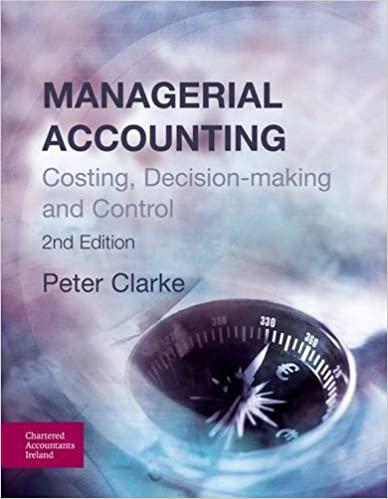Answered step by step
Verified Expert Solution
Question
1 Approved Answer
Ravsten Company uses a job-order costing system. On January 1, the beginning of the current year, the company's inventory balances were as follows: Raw materials






Ravsten Company uses a job-order costing system. On January 1, the beginning of the current year, the company's inventory balances were as follows: Raw materials Work in process Finished goods $ 16,000 $ 10,000 $ 30,000 s The company applies overhead cost to jobs on the basis of machine-hours. For the current year, the company estimated that it would work 36,000 machine-hours and incur $153,000 in manufacturing overhead cost. The following transactions were recorded for the year: a. Raw materials were purchased on account: $200,000. b. Raw materials were requisitioned for use in production: $190,000 (80% direct and 20% indirect). c. The following costs were incurred for employee services: Direct labour Indirect labour Sales commissions Administrative salaries $160,000 $ 27,000 $ 36,000 $ 80,000 d. Heat, power, and water costs were incurred in the factorv: $42.000. d. Heat, power, and water costs were incurred in the factory: $42,000. e. Prepaid insurance expired during the year: $10,000 (90% relates to factory operations, and 10% relates to selling and administrative activities). f. Advertising costs were incurred, $50,000. g. Depreciation was recorded for the year. $60,000 (85% relates to factory operations, and 15% relates to selling and administrative activities). h. Manufacturing overhead cost was applied to production. The company recorded 40,000 machine-hours for the year. i. Goods that cost $480,000 to manufacture according to their job cost sheets were transferred to the finished goods warehouse. j. Sales for the year totalled $700,000 and were all on account. The total cost to manufacture these goods according to their job cost sheets was $475,000. Required: 1. Prepare journal entries to record the transactions given above. (Do not round intermediate calculations. If no entry is required for a transaction/event, select "No journal entry required" in the first account field.) 2. Prepare T-accounts for inventories, Manufacturing Overhead, and Cost of Goods Sold. Post relevant data from your journal entries to these T-accounts (don't forget to enter the opening balances in your inventory accounts). Compute an ending balance in each account. Raw Materials Manufacturing Overhead Beg. Bal. s Beg. Bal. End. Bal. End. Bal. Work in Process Cost of Goods Sold Beg. Bal. Beg. Bal. End. Bal. End. Bal. Finished Goods Beg. Bal. End. Bal. es 3-a. Is manufacturing overhead underapplied or overapplied for the year? O Underapplied overhead O Overapplied overhead 3-b. Prepare a journal entry to properly dispose of any balance in the Manufacturing Overhead account. (Do not round intermediate calculations and round your final answers to 2 decimal places. If no entry is required for a transaction/event, select "No journal entry required" in the first account field.) View transaction list Journal entry worksheet
Step by Step Solution
There are 3 Steps involved in it
Step: 1

Get Instant Access to Expert-Tailored Solutions
See step-by-step solutions with expert insights and AI powered tools for academic success
Step: 2

Step: 3

Ace Your Homework with AI
Get the answers you need in no time with our AI-driven, step-by-step assistance
Get Started


